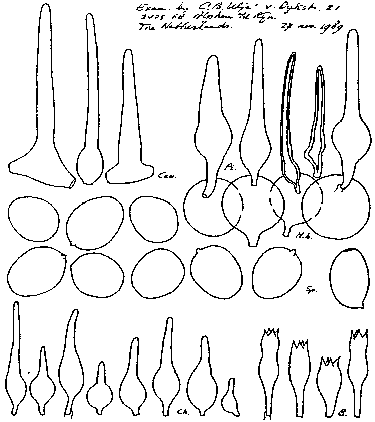Macroscopic features |
Pileus 10-25 (-30) mm broad, subcylindric when young, becoming obtusely conic to convex, deer-brown, cinnamon, paler towards margin. Lamellae narrowly adnate, whitish to blackish. Stipe 50-90 x 0.25-1 mm, white, somewhat thickened towards base (macroscopical description after M. Lange & A.H. Smith, l.c.). |
Microscopic features |
Spores (from type) [60,1,1] 8.3-10.3 x 6.7-8.4 µm, av. L= 9.1-9.8, av. B= 7.3-7.9 µm, Q= 1.10-1.40, av. Q= 1.25, broadly ovoid; germ pore weakly eccentric, c. 2 µm wide. Basidia 18-40 x 8-11 µm, 4-spored. Pseudoparaphyses (3-)4-6(-7) per basidium. Cheilocystidia 20-40 x 8-14 µm, lageniform with tapering neck and 2.5-3.5 µm wide apex. Pleurocystidia not found (present and lageniform according to original description). Pileocystidia 40-70(-90) x 9-16 µm, lageniform with tapering neck, 2.5-5(-7) µm wide at apex. Sclerocystidia up to 100 µm long, rather scanty. Clamp-connections present. |
Habitat |
Gregarious on fallen branches. Not known from the Netherlands. |
Remarks |
Coprinus eurysporus is close to C. impatiens but has spores that are broader than in the latter species. The spores are not ellipsoid as in subsect. Setulosi normal but are broadly rounded subtruncate-ovoid. According to its authors C. eurysporus should have lageniform pleurocystidia. The first author of this paper was unable to find pleurocystidia in the type-material. Coprinus eurysporus would be the only species with lageniform pleurocystidia in subsect. Setulosi. In the other species with pleurocystidia in this subsection, they are inflated, globose to broadly subutriform. |

[Copyright © by Uljé]